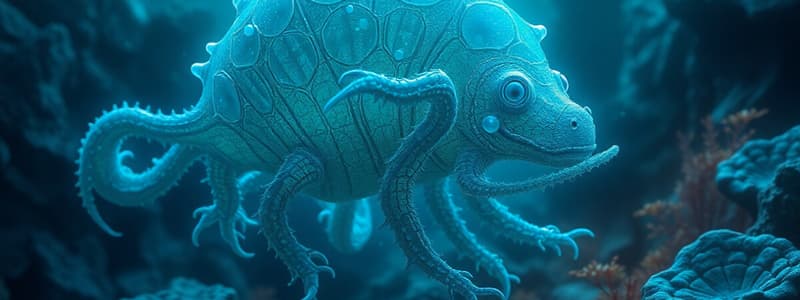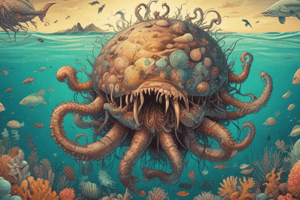Podcast
Questions and Answers
Which characteristic is exclusively associated with vertebrates and not observed in protochordates?
Which characteristic is exclusively associated with vertebrates and not observed in protochordates?
- Replacement of the notochord by a vertebral column. (correct)
- Presence of a notochord at some stage of development.
- A post-anal tail extending beyond the anus.
- Bilateral symmetry and a coelom.
How does the circulatory system of cyclostomes (Agnatha) differ significantly from that of other fish classes (Chondrichthyes and Osteichthyes)?
How does the circulatory system of cyclostomes (Agnatha) differ significantly from that of other fish classes (Chondrichthyes and Osteichthyes)?
- Cyclostomes have a cartilaginous heart, whereas other fish have a bony heart.
- Cyclostomes have a two-chambered heart, while other fish have a three-chambered heart.
- Cyclostomes possess an open circulatory system, unlike the closed systems in other fish.
- Cyclostomes have a closed circulatory system. (correct)
A researcher discovers a new aquatic vertebrate species possessing placoid scales modified into backwardly directed teeth. Based on this feature, to which class does this species most likely belong?
A researcher discovers a new aquatic vertebrate species possessing placoid scales modified into backwardly directed teeth. Based on this feature, to which class does this species most likely belong?
- Agnatha
- Osteichthyes
- Amphibia
- Chondrichthyes (correct)
Which of the following best explains why adult lampreys migrate from marine environments to freshwater environments?
Which of the following best explains why adult lampreys migrate from marine environments to freshwater environments?
How does the absence of a swim bladder in Chondrichthyes influence their behavior and survival, and what compensatory mechanism do they employ?
How does the absence of a swim bladder in Chondrichthyes influence their behavior and survival, and what compensatory mechanism do they employ?
How does the persistent notochord in Chondrichthyes directly influence their physiological capabilities, especially when contrasted with the vertebral column found in Osteichthyes?
How does the persistent notochord in Chondrichthyes directly influence their physiological capabilities, especially when contrasted with the vertebral column found in Osteichthyes?
In what way does the presence or absence of an operculum in fish species most significantly impact their respiratory efficiency and adaptability to varying aquatic environments?
In what way does the presence or absence of an operculum in fish species most significantly impact their respiratory efficiency and adaptability to varying aquatic environments?
Considering the reproductive strategies of Chondrichthyes, how does viviparity, coupled with internal fertilization via claspers, confer an evolutionary advantage in challenging marine environments?
Considering the reproductive strategies of Chondrichthyes, how does viviparity, coupled with internal fertilization via claspers, confer an evolutionary advantage in challenging marine environments?
How does the integration of electric organs or poisonous sting organs within the predatory strategies of certain Chondrichthyes species reflect an evolutionary adaptation to specific ecological niches?
How does the integration of electric organs or poisonous sting organs within the predatory strategies of certain Chondrichthyes species reflect an evolutionary adaptation to specific ecological niches?
Given the diverse habitats of Osteichthyes—ranging from marine to fresh water and even specialized pet environments—how do their osmoregulatory mechanisms differ to maintain homeostasis in varying salinity concentrations?
Given the diverse habitats of Osteichthyes—ranging from marine to fresh water and even specialized pet environments—how do their osmoregulatory mechanisms differ to maintain homeostasis in varying salinity concentrations?
Flashcards
What is a vertebrate?
What is a vertebrate?
Animals with a notochord replaced by a vertebral column.
What are Agnathostoma?
What are Agnathostoma?
Vertebrates lacking jaws, possessing a circular, suctorial mouth.
What are Gnathostome?
What are Gnathostome?
Vertebrates possessing jaws.
What are Pisces?
What are Pisces?
Signup and view all the flashcards
What are Chondrichthyes?
What are Chondrichthyes?
Signup and view all the flashcards
Swim bladder/Air bladder
Swim bladder/Air bladder
Signup and view all the flashcards
Operculum (Gill)
Operculum (Gill)
Signup and view all the flashcards
"Claspers"
"Claspers"
Signup and view all the flashcards
Viviparous
Viviparous
Signup and view all the flashcards
Notochord
Notochord
Signup and view all the flashcards
Vetebrates
Vetebrates
Signup and view all the flashcards
Study Notes
- All vertebrates are chordates, but not all chordates are vertebrates, some are protochordates
- Vertebrates have a vertebral column replacing the notochord
- Vertebrates respire through gills or lungs
- Vertebrates have a muscular heart with 2, 3, or 4 chambers
- Vertebrates have kidneys for excretion
- Vertebrates are usually unisexual
Gonads
- Vertebrates possess ovaries and testes
Vertebrate Groups
- Agnathostoma: Characterized by the absence of jaws
- Mouth is not bounded by jaws, thus they are jawless
- Gnatostome: Characterized by the presence of jaws
- Mouth has jaws, making them jawed vertebrates
Agnatha: Class Cyclostomata
- All members are aquatic
- Circular sucking mouth without jaws
- Paired appendages are absent
- Scales are absent
- All living members are ectoparasites on fish
- Have 6-15 pairs of gill slits
- Cranium and vertebral column are cartilaginous
- Closed circulatory system
- Marine, but migrate to fresh water for spawning
- Adults die after laying eggs and sperm
- Larvae undergo metamorphosis and return to marine habitat
- Examples: Petromyzon (Lamprey), Myxine (Hagfish)
Gnathostome: Pisces (Superclass)
- All members are aquatic
- Scales are present
- Possess paired and unpaired fins
- Two-chambered heart
- Respiration through gills
- Poikilotherm/cold blooded
- Unisexual
Chondrichthyes
- Marine habitat
- Cartilaginous endoskeleton
- Placoid scales modified to form backwardly directed teeth
- Swim bladder/air bladder absent preventing constant sinking
- Operculum (Gills cover) absent
- Predatory in nature with electric organs or poison stings
- Internal fertilization
Osteichthyes
- Marine and fresh water habitat
- Bony endoskeleton
- Cycloid, ctenoid scale
- Swim bladder/air bladder provides buoyancy
- Operculum (Gills cover) present
- External fertilization
- Viviparous (usually)
- Notochord is persistent throughout life
- Claspers (copulatory structures) are associated with the pelvic fin in male
- Reproductive organ example: Carcharadon (White shark)
- Trygon (sting ray)
- Torpedo (electric ray)
- Pristis (saw fish)
- Scoliodon (dog fish)
Oviparous
- Notochord is replaced by the vertebral column
- Marine habitat, Exocoetus (flying fish)
- Hippocampus (sea horse) contains a broad pouch
- Fresh water habitat, Labeo (Rohu), Clarias (Magur)
- beta (fighting fish)
- pterophyllum (angle fish)
Studying That Suits You
Use AI to generate personalized quizzes and flashcards to suit your learning preferences.
Related Documents
Description
Explore the characteristics of vertebrates, including their vertebral column, respiration methods, and circulatory systems. Discover the classification of vertebrates into jawless (Agnathostoma) and jawed (Gnatostome) groups. Focus on Agnatha, specifically Class Cyclostomata, noting their parasitic nature and unique features.


